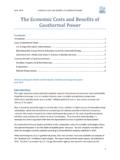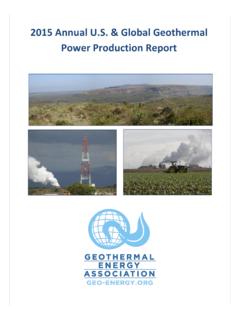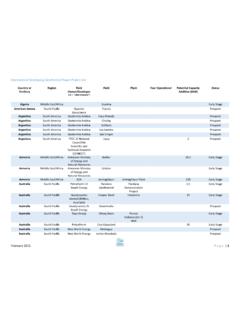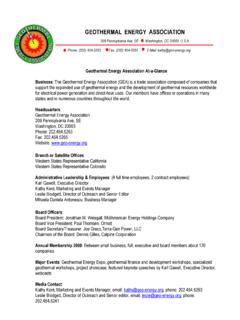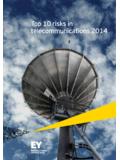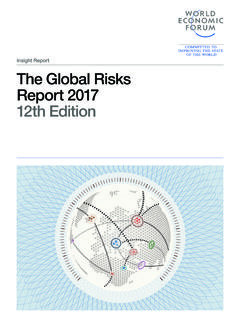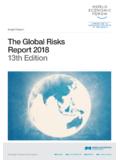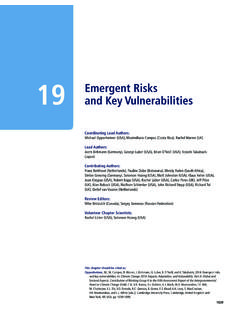Transcription of The Manageable Risks of Conventional …
1 The Manageable Risks of Conventional hydrothermal geothermal Power Systems February 2014 1 The Manageable Risks of Conventional hydrothermal geothermal Power Systems: A Factbook on geothermal Power s Risks and Methods to Miti g ate Them The Manageable Risks of Conventional hydrothermal geothermal Power Systems February 2014 2 The geothermal Energy Association (GEA) has prepared this document for policy makers and the interested public to understand more about geothermal power s unique Risks and about past and current policy and market approaches to address them. This report is intended to be a companion to a report published in October of 2013, The Values of geothermal Energy.
2 That report outlined the positive values of geothermal energy, including supplying both firm and flexible grid operation support, creating jobs, having a small land footprint, and producing near-zero emissions. For an investor or developer, geothermal projects have significant benefits, as detailed in The Values of geothermal Energy, but they also encounter unique Risks . Many of the unique Risks relate to finding, developing and producing from the geothermal resource. This report outlines the Risks involved in exploration, drilling, development and operation of a geothermal project, and describes past and ongoing effort by the and global policies to address those Risks .
3 This analysis should underscore that policies aimed at incentivizing renewable power for taking a one size fits all approach may miss the mark with geothermal investments due to the unique nature of their risk profile. geothermal power has an important part to play in the energy systems of the western United States and many other regions of the world. With increased understanding of its unique benefits and Risks , key decision makers will be better equipped to support and promote the geothermal industry, leading to an expansion of geothermal power in the coming decades.
4 WRITTEN AND PREPARED BY BENJAMIN MATEK geothermal ENERGY ASSOCIATION FEBRUARY 2014 Cover Page Pictures Courtesy of Sam Abraham (Top Left) Rainbow: Puna, Big Island, Hawaii (Top Right) Lava flow: Kalapana, Big Island, Hawaii (Bottom Left) Hot spring (foliage and steam): Wotten Waven, Dominica Pictures Courtesy of Terra-Gen (Bottom Right) Beowawe Power Plant, Nevada The Manageable Risks of Conventional hydrothermal geothermal Power Systems February 2014 3 Acknowledgments: GEA would like to give a special thank you to Leslie Blodgett and Karl Gawell from the geothermal Energy Association; Mike Long from POWER Engineers/Galena Advisors; John Pritchett from Leidos Corporation; Jefferson Tester, Sean Hillson, Koenraad Beckers, Andrea Aguirre, Maciej Lukawski and Erin Camp from Cornell Energy Institute; Josh Nordquist and Heidi Bethel from Ormat Technologies; and Ann Robertson-Tait from GeothermEx, Inc.
5 For their invaluable insight on this project. GEA would like to thank Sam Abraham for contributing his beautiful photography for use in this publication. Please Note: The findings, interpretations, and conclusions expressed in this report are entirely those of the author and should not be attributed in any manner to the geothermal Energy Association, to its affiliated organizations, or to members of its Board of Directors. The geothermal Energy Association does not guarantee the accuracy of the data included in this publication and accepts no responsibility whatsoever for any consequence of its use.
6 Any reference to any specific commercial product, process, or service by trade name, trademark, manufacturer, or otherwise, does not necessarily constitute or imply an endorsement, recommendation, or favoring by GEA. GEA does not assume, and hereby disclaims, any liability that may result from any reliance on or use of any information contained in this publication, or for any loss or damage caused by errors or omissions in this publication. The Manageable Risks of Conventional hydrothermal geothermal Power Systems February 2014 4 Table of Contents Section 1: The geothermal Power Development Process.
7 5 Introduction .. 5 Different Economics, Different 5 geothermal Power s Risks to Project Development .. 10 Resource Risk .. 10 geothermal Drilling Risks .. 13 Project Financing Risk .. 15 Operational & Maintenance Risks .. 17 Section 2: Past and Ongoing Successful geothermal Programs to Reduce Risk .. 20 A Selection of Government or Quasi-Government Exploration and Drilling Programs .. 21 Overview .. 21 Selected Historic Exploration & Drilling Programs .. 22 Select Current and International Exploration & Drilling Programs and Initiatives 24 Standardized geothermal Reporting Codes and Exploration Practices.
8 26 Technological Advancement .. 27 Notable Recent Reports .. 28 Section 3: Conclusion .. 30 References .. 32 The Manageable Risks of Conventional hydrothermal geothermal Power Systems February 2014 5 Section 1: The geothermal Power Development Process Introduction This paper provides a brief description of the Risks associated with primarily Conventional hydrothermal geothermal power projects (not primarily Enhanced geothermal Systems or EGS) and describes shared policy and market approaches intended to address them. geothermal power projects have very unique development timelines that are substantially different from most, if not all, other energy technologies.
9 In the first section, a brief discussion of geothermal power plant economics is followed by a list of the problematic Risks that hinder or raise costs of geothermal power, and the second section lists a selection of past and ongoing programs to reduce risk. Finding effective and economical ways to reduce these Risks is considered to be the number one way to expand the use of geothermal power globally. Different Economics, Different Risks geothermal power projects have very unique development timelines that are substantially different from most, if not all, other energy technologies. A greenfield project typically starts with several years of exploration and drilling, followed by a brief construction period, and then several decades of operation.
10 This timeline creates unique Risks and challenges for the geothermal industry. The one size fits all policy approach, which attempts to levelize the playing field for renewable energy technologies, often misses the mark when it comes to geothermal power, leaving a valuable renewable power source lacking proper support. A few of the distinguishing factors of geothermal power that differentiate it from other energy technologies are listed below: Even with high upfront capital costs, geothermal power is a competitive renewable energy source. The absence of fuel costs and other variable costs over the long 50+ year project life span give geothermal power the lowest levelized cost ($ ) of any renewable energy technology with the exception of wind power (at $ ; 3% less).
